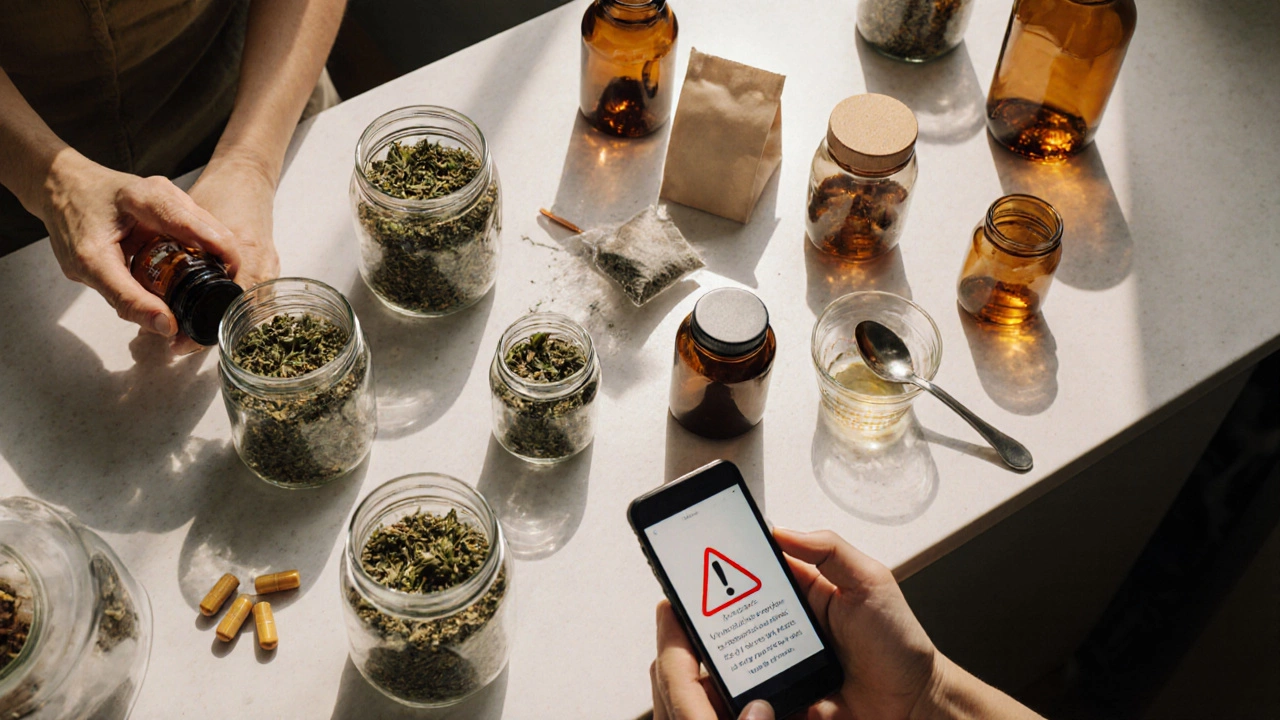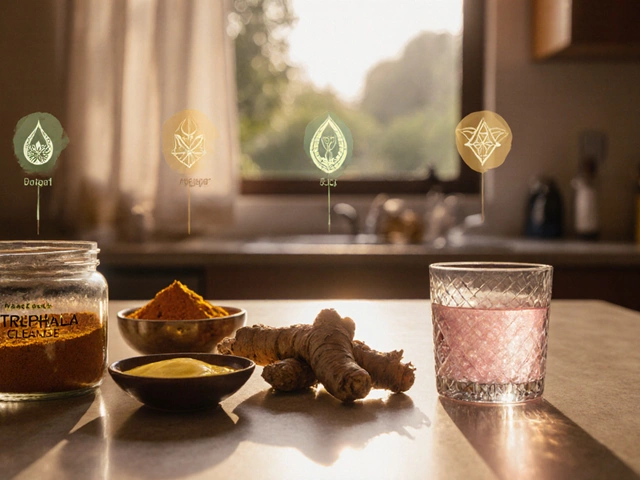Herbal Supplement Safety Checker
Instructions
Select the herbs you're considering taking and enter their daily doses. This tool compares your intake against safe limits and warns about potential interactions.
Your Results
Enter your selections and click "Check Safety" to see results.
Key Takeaways
- Herbal supplements can interact with medications, vitamins, and minerals, leading to adverse effects.
- Excessive doses may cause liver toxicity, kidney damage, or hormone imbalance.
- Follow recommended dosages, watch for quality certifications, and consult a health professional before stacking multiple herbs.
- Regulatory oversight is limited; third‑party testing and clinical studies are essential for safety.
- Gradual introduction and monitoring help you enjoy benefits without unnecessary risks.
When it comes to herbal supplements are plant‑derived products taken to support health, such as extracts, teas, capsules, or powders, many people assume “more is better”. The reality is far messier: the body can only process a certain amount of bioactive compounds before they start to clash with each other or with prescription drugs. Below we unpack why taking too many herbal supplements can be risky, how to spot red flags, and what practical steps keep you on the safe side.
Why People Stack Herbal Supplements
Fitness enthusiasts, busy professionals, and seniors alike turn to herbs for a quick boost-energy, immunity, stress relief, or joint comfort. The allure of “stacking” comes from marketing hype and anecdotal success stories. For example, combining Echinacea with a vitamin C supplement is popular during cold season because each is believed to support the immune system. While the logic sounds sound, the science tells a more nuanced story.
How Excess Leads to Trouble
Three core mechanisms explain why “too much” can be harmful:
- Pharmacodynamic overload: Multiple herbs may target the same physiological pathway, amplifying effects beyond safe limits. For instance, both St.John’sWort and certain antidepressants increase serotonin levels, raising the risk of serotonin syndrome.
- Pharmacokinetic interference: Some herbs affect enzyme activity in the liver, altering how other compounds are metabolized. Ginkgo biloba can inhibit CYP3A4, a key enzyme that breaks down many drugs, potentially leading to higher blood concentrations.
- Direct toxicity: Certain herbs have narrow therapeutic windows. Overuse of kava has been linked to severe liver toxicity when taken in high doses for extended periods.
Common Interactions with Vitamins and Minerals
Herbal formulas seldom exist in isolation. They often coexist with vitamins and minerals such as calcium, magnesium, or iron. These nutrients can either boost or blunt herb activity. For example, iron supplements chelate with polyphenols in green tea, reducing iron absorption. Conversely, high doses of vitaminE may increase the anticoagulant effect of garlic extract, heightening bleeding risk.
Organ‑Specific Risks
While mild side effects like stomach upset are common, chronic overuse can damage specific organs:
- Liver toxicity often emerges from herbs containing pyrrolizidine alkaloids, like comfrey, or from excessive kava consumption.
- Kidney damage has been reported with long‑term high‑dose use of aristolochic acid‑containing herbs, which can lead to interstitial nephritis.
- Hormonal imbalance may result from phytoestrogen‑rich herbs (e.g., red clover) taken in large amounts, potentially affecting thyroid or reproductive health.
Regulatory Landscape and Quality Assurance
In the United States, the FDA classifies herbal supplements as dietary supplements, not drugs. This means manufacturers are not required to prove safety or efficacy before market entry. Instead, they must notify the FDA of any new ingredients and ensure good manufacturing practices (GMP). Consumers should look for third‑party certifications (USP, NSF) and check if clinical studies have evaluated the specific herb and dosage.
Practical Guidelines for Safe Use
Below is a checklist you can keep on the fridge or phone:
- Start with one supplement at a time; wait 2‑4 weeks before adding another.
- Stick to the manufacturer’s recommended dose; avoid “mega‑doses” marketed for quick results.
- Read labels for active ingredient amounts, not just proprietary blends.
- Verify the product has a third‑party test seal (USP, NSF, ConsumerLab).
- Discuss your supplement list with your primary care physician, especially if you take prescription meds.
- Watch for side effects: unusual bruising, yellow skin, persistent diarrhea, or rapid heartbeat.
- Consider periodic blood work to monitor liver enzymes and kidney function when using multiple herbs long‑term.

Comparing Popular Herbs - Typical Dose vs. Upper Safe Limit
| Herb | Typical Daily Dose | Upper Safe Limit* (per day) | Common Risks When Exceeded |
|---|---|---|---|
| Echinacea (root) | 300mg | 900mg | Allergic reactions, stomach upset |
| Ginkgo biloba (leaf) | 120mg | 240mg | Bleeding, interaction with anticoagulants |
| St.John’sWort (flower) | 300mg | 600mg | Serotonin syndrome, reduced drug efficacy |
| Turmeric (curcumin) | 500mg | 1500mg | Kidney stones, gastrointestinal irritation |
| Kava (root) | 70mg | 150mg | Liver toxicity, dizziness |
*Upper limits are based on pooled data from peer‑reviewed clinical trials up to 2024. Individual tolerance may vary.
When to Seek Professional Help
If you notice any of the following, contact a healthcare provider promptly:
- Yellowing of skin or eyes (possible liver injury)
- Unexplained bruising or prolonged bleeding
- Sudden weight loss, persistent nausea, or vomiting
- New or worsening anxiety, mood swings, or insomnia after starting a supplement
- Changes in blood pressure or heart rate
Bottom Line
Herbal supplements can be a valuable addition to a healthy lifestyle, but more isn’t always better. Over‑stacking can lead to drug interactions, organ toxicity, and unpredictable side effects. By respecting recommended doses, choosing vetted products, and keeping an open line with your doctor, you can reap the benefits without jeopardizing your health. Remember, the most reliable way to protect yourself is a balanced approach-one supplement at a time, with evidence‑backed doses.
Being cautious doesn’t mean you can’t enjoy the natural boost that herbal supplements offer; it just means doing so smartly.
Frequently Asked Questions
Can I take herbal supplements with prescription medication?
Yes, but only after checking for known interactions. Herbs like St.John’sWort, ginkgo, and garlic can affect how medicines are processed, potentially increasing side effects or reducing efficacy. Always ask your doctor or pharmacist before mixing.
Is it safe to take multiple herbs together?
A limited stack can be safe if the herbs act on different pathways and stay within recommended doses. However, stacking increases the chance of overlapping effects, especially on liver enzymes. Start with a single herb, monitor how you feel, then add another after a few weeks.
How do I know if a supplement is high‑quality?
Look for third‑party testing seals like USP, NSF, or ConsumerLab. Check that the label lists exact ingredient amounts rather than “proprietary blend”. The manufacturer should follow GMP standards and provide batch numbers.
What are the signs of liver toxicity from herbs?
Early signs include fatigue, loss of appetite, nausea, and abdominal pain. As it progresses, you may notice dark urine, pale stools, or yellowing of skin and eyes. If any appear, stop the supplement and seek medical attention.
Do herbal supplements expire?
Yes. Potency declines over time, especially for powders and tinctures exposed to light or heat. Most manufacturers recommend using products within 2‑3 years of the manufacture date.

 What Are the Disadvantages of IVF? Real Risks and Challenges You Should Know
What Are the Disadvantages of IVF? Real Risks and Challenges You Should Know
 Can Prescription Drugs Be Ordered Online? Your Guide to Online Pharmacies
Can Prescription Drugs Be Ordered Online? Your Guide to Online Pharmacies
 Understanding the Downsides of Mail-Order Pharmacies
Understanding the Downsides of Mail-Order Pharmacies
 Ayurvedic Cleanse Side Effects: What to Watch For
Ayurvedic Cleanse Side Effects: What to Watch For
 Understanding Chemotherapy's Impact on Long-Term Recovery
Understanding Chemotherapy's Impact on Long-Term Recovery